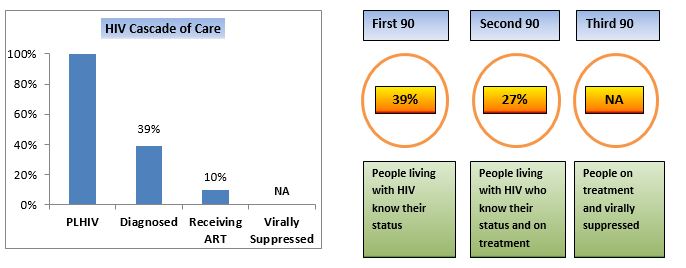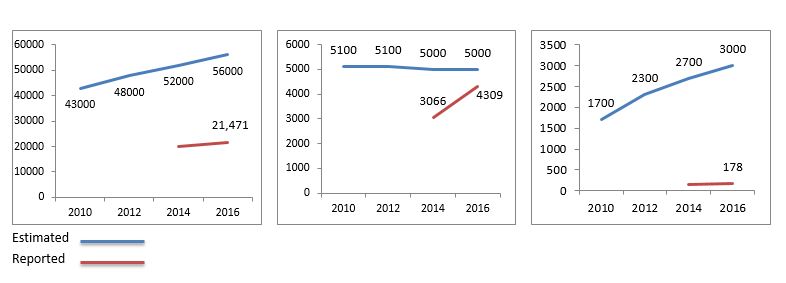Sociodemographic data
- Total population (in millions) 41.2
- Maternal mortality per 100 000 live births : 311
- Life expectancy at birth (years) : 63
- Total fertility rate (births per woman) : 4.5
- GNI per capita, PPP (current international US$) :3 990
- Health expenditure, total (% of GDP) : 8.4
- Health expenditure per capita (current US$) : 130
- Human Development Index Value : 0.49
HIV care cascade and progress towards 90-90-90

Epidemiological data (2016)
HIV estimates and case notification
|
|
Estimated |
Reported |
|
HIV prevalence in general population |
0.2 [0.1 - 0.4] |
|
|
People living with HIV (PLHIV) |
56 000 |
21,471 |
|
New infections |
5,000 [1900 - 9400] 4,309 |
|
|
AIDS-related deaths |
3,000 [2200 - 4300] 178 |
|
|
|
|
|
HIV in specific populations
|
|
Survey data |
|
Size estimate |
Routine testing and VCT data |
|
|
Key populations |
Prevalence |
|
|
No tested |
HIV+ cases (%) |
|
Sex workers (SW) |
1.3% (n=4134) in 2015 |
|
131 |
0.7% |
|
|
Men having sex with men (MSM) |
1.4% (n=4142) in 2015 |
|
4123 |
1% |
|
|
People who inject drugs (PWIDs) |
|
||||
|
Prisoners |
|
||||
|
Populations in health settings |
|
|
|
|
|
|
TB patients |
|
|
|
3659 |
7.7% |
|
Pregnant women |
|
|
|
90,865 |
0.1% |
|
Blood Donors |
|
|
|
317,210 |
0.5% |
|
Clients of testing services |
|
|
|
59815 |
4.8% |
Response
Policy implementation
|
|
|
|
Policy CD4 threshold adults and adolescents |
CD4 <=500 cells/mm3 |
|
Recommended initiation threshold children |
< 5 years (as per WHO 2013 guidelines) |
|
Policy of lifelong ART to pregnant & breastfeeding women |
Option B+ |
|
Implementation of lifelong ART to pregnant & breastfeeding women |
Done country-wide |
|
Implementation of national policy on viral load monitoring |
Not implemented |
HIV testing coverage in key populations *
Antiretroviral therapy and PMTCT coverage
References
(1) http://www.prb.org/pdf16/prb-wpds2016-web-2016.pdf; (2) WHO.EMRO Regional Surveillance Data; (3) UNAIDS/WHO estimates 2016; (4) Global AIDS Monitoring (GAM) 2016.






